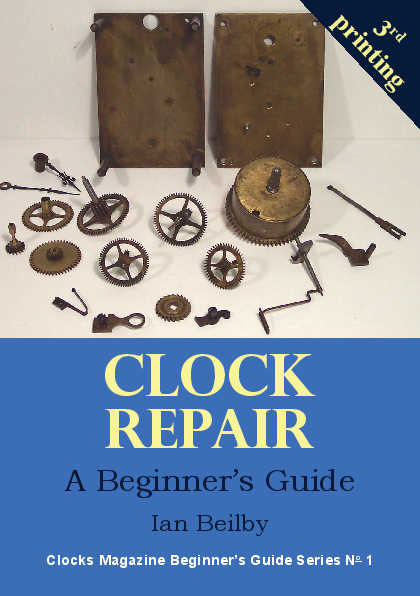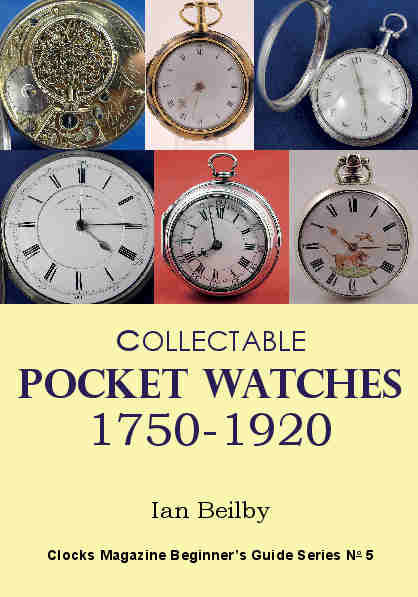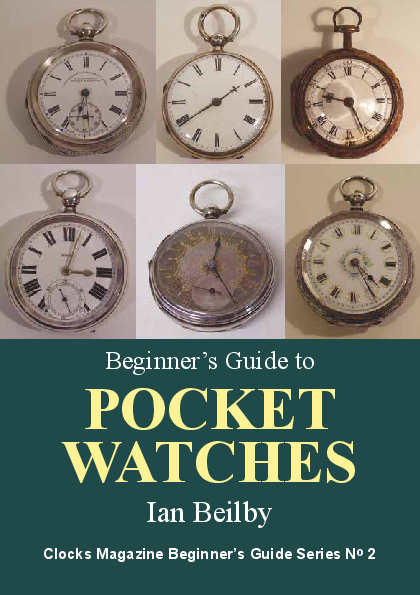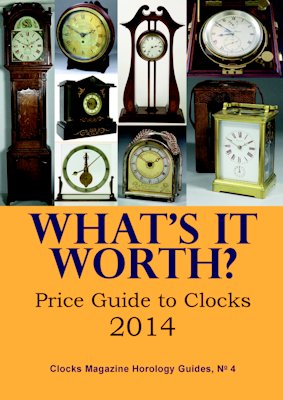|
| Acorn clock | Type of American shelf clock said to resemble an acorn in shape |
| Act of Parliament clock | see tavern clock |
| Analemma | Figure-of-eight shape describing the Equation of Time |
| Anchor escapement | see escapement, anchor |
| Anniversary clock | Clock with torsion pendulum, which runs for over a year at one winding. Also known as 'four-hundred day clock'. |
| Arbor | Spindle or axle on which clock wheels, pinions etc are mounted. |
| Atmos clock | Clock which derives its motive power from variations in atmospheric pressure. |
| Autowinder | Mechanism based around an electric motor which winds a clock automatically. |
| Back cock | Single-foot bracket, usually of brass, which holds the rear pivot of the escape wheel |
| Back plate | see movement plates |
| Balance (wheel) | Non-toothed wheel of watch or chronometer movement, or platform escapement which spins alternately clockwise and anticlockwise, under the influence of the balance spring, moving a lever or detent on each pass. This lever or detent governs the rate at which power escapes from the train and thus the timekeeping of the mechanism. |
| Balance, floating | Balance suspended in position vertically by helical balance spring |
| Balance spring | Coiled spring which controls the back and forth spinning of the balance wheel |
| Balance staff | Arbor on which the balance wheel pivots |
| Balloon clock | Clock in the shape of a hot-air balloon, usually French |
| Banjo clock | Clock said to resemble a banjo, invented by American clockmaker Simon Willard, 1753-1848, of Roxbury, near Boston, Massachusetts. |
| Barrel | Short cylinder of brass which contains the mainspring. |
| Barometer | Instrument for measuring atmospheric pressure. |
| Beat (setting) | The 'tick-tock' of the clock as the escapement operates. The 'tick' should be of equal length to the 'tock', beat-setting being the process of making sure this happens, after which the clock is said to be 'in beat'. |
| Black Forest clock | Clock from the Schwarzwald or Black Forest area of Germany, often with wooden movements manufactured on a cottage-industry basis. |
| Blu(e)ing | The process of heating steel until it changes colour to blue. |
|
Bob |
The part of the pendulum at the far end of the rod from the suspension. The bob accounts for most of the weight of the pendulum |
| Bodging | Repairing a clock badly, in a very amateurish manner. |
| Bornholm clocks | Clocks from the Danish island of Bornholm. |
| Bracket clock | Style of spring-driven British clock, once thought to have stood on a matching bracket attached to the wall. |
| Break-arch | The arch which sits on top of an otherwise square dial, the base of the arch being somewhat narrower than the top of the square. |
| Broach(ing) | The process of widening a hole, usually a pivot hole, using a tool of the same name |
| Bush(ing) | The process of plugging elongated or misshapen holes in movement plates using small cylinders of brass (know as 'bushes' or 'buchons') so that pivots will run properly. |
| Caddy top | Top moulding of a longcase clock or bracket clock featuring an S-shape, wider at the bottom than the top. |
| Cannon pinion | Pinion which drives the motionwork of a clock, part of which takes the form of a hollow cylinder (thought to resemble a cannon) on to which the minute hand fits |
| Carriage clock | Small travelling clock, usually in a brass or decorated brass case with a platform escapement and a carrying handle, often with an outer case finished in leather. |
| Cartel clock | A highly decorative wall clock, usually French, sometimes English, made from ormolu. |
| Cartwheel dial | Longcase clock dial with cut-outs behind the chapter ring giving a superficial resemblance to a cart wheel. |
| Centre arbor | Arbor of centre wheel which revolves once every 12 hours to which the cannon pinion is attached |
| Centre wheel | The wheel, usually the third wheel of the time train, on the arbor of which the minute hand is mounted. |
| Champlevé | Type of enamelling popular on carriage clocks, the enamel sitting in depressions engraved in brass. |
| Chain, fusee | Fine bicycle-type chain which winds on to a clock barrel and connects it to a fusee allowing the power of the mainspring to be delivered evenly to the train |
| Chapter ring | The ring on a clock dial which shows the hours or 'chapters', showing religious derivation: the first clocks were in monasteries, reminding the various chapters of monks of the times of their religious duties. |
| Chime | Short tune played by clock on the hours and quarters. |
| Chinoiserie | Oriental style lacquer work used on clock cases. |
| Chronometer | Type of clock specially designed to keep accurate time at sea, usually held on gimbals in a wooden box. |
| click, clickspring | The click is a ratchet pawl used in winding springs, the clickspring being a small spring which keeps the click in engagement with the ratchet. |
| Collet | Circular ring used to hold clock parts on arbors etc. |
| Comtoise clock | Style of clock made in the Franche Comté region of France, also known as Morez or Morbier clocks |
| Congreve clock | Clock devised by British inventor William Congreve, 1772-1828, in which the escapement features a ball running in a zig-zag channel on a brass plate. |
| Countwheel | Strike train wheel which determines the number of times the clock strikes at a given hour. |
| Crown wheel | Escape wheel in verge escapement with teeth are at right angles to the plane of the wheel, resembling a crown. |
| Crown wheel escapement | see escapement, verge. |
| Crutch | Lever which transmits impulse from escape wheel to pendulum and transmits the beat from the pendulum to the pallets |
| Cuckoo clock | Black Forest clock, often highly carved and shaped like a house, from which a carved cuckoo appears on the hour while the clock strikes with a 'cuckoo' sound. |
| Depthing |
Establishing the correct meshing of wheels and pinions in a clock train, often using a depthing tool |
| Detent |
Stop which holds the ratchet of the maintaining power in a chronometer |
| Dial |
Face of clock or watch against which hands show the time |
| Dial, brass |
Face of longcase clock made of brass, usually with silvered chapter ring |
| Dial, painted |
Face of longcase clock, post 1770s, which has the chapters, spandrels and other decoration painted on to an iron sheet, rather than being engraved and applied on to brass. Also known as a 'white' dial |
| Draw |
Part of the escapement action in which the pallet nib is drawn inwards by the tooth of the escape wheel against which it bears |
| Drop-trunk |
Also incorrectly known as 'drop-dial', the drop-trunk wall clock is a clock similar to an English dial clock but where the box which conceals the pendulum projects below the circumference of the dial |
| Drop |
Part of the escapement action in which the pallet nib is falls or 'drops' on to the tooth of the escape wheel |
| Engine-turning |
Type of decoration often used on the plates of American watches, also known as 'damascening' due to the similarity of the effect to damask |
| English dial clock |
Type of wall clock which originated in Britain in which only the dial is usually visible, the movement, pendulum etc being hidden behind it. These clocks were commonly used in public buildings such as schools, post-offices, government buildings etc |
| Equation of Time |
The difference between apparent time and mean time, which can differ by up to 15 minutes per day, mean time being the average or mean of the differing day lengths caused by wobble in the earth's orbit |
| Escapement |
The mechanism at the end of the wheel
train which allows the power to escape in regular bursts, thus allowing the accurate display of the passage of time |
| Escapement, anchor |
Type of escapement popular with the makers of English longcase clocks, the pallets of which are similar in shape to a ship's anchor
|
| Escapement, bent-strip |
Escapement used particularly by American clockmakers, the pallets of which are fashion out of a strip of metal bent to shape
|
| Escapement, co-axial |
Escapement designed by George Daniel which compensates for the drying out of oil in watches |
| Escapement, cylinder |
Escapement in which part of the balance staff is formed into a cylinder on which the teeth of the escape wheel act to allow power to escape |
| Escapement, dead-beat |
Escapement without recoil, giving more accurate timekeeping than the anchor escapement |
| Escapement, duplex |
Watch escapement designed by George Daniel to compensate for the drying up of lubricants in the movement |
| Escapement, lever |
Type of escapement, common in watches, in which the pallets form part of a lever which is rocked back and forth by a pin on the balance wheel to release power in regular bursts |
| Escapement, platform |
Type of lever or cylinder escapement mounted on a platform to make it easily removable from the wheel train, often used in carriage clocks |
|
Escapement, recoil |
see Escapement, anchor |
| Escapement, tic-tac |
Type of recoil escapement, the pallets of which embrace just one or two teeth of the escape wheel |
| Escapement, verge |
Primitive form of escapement in which a verge swinging back and forth under the influence of a balance or a pendulum interrups the revolution of a crown wheel, allowing the wheel to turn at a regular and predictable rate and thus the clock to keep time |
| Escape wheel |
Wheel on which the nibs of the pallets act to release power from the going train in a regulated manner |
| Falseplate |
Metal plate which attaches to the rear of the dial of a white or painted dial longcase and to which the movement in turn is attached |
| Finial |
Decoration used to 'top-off' part of the case of a clock. Finials are commonly found at the top corners of the case of a longcase or bracket clock and on the bellstand of a lantern clock |
| Fly |
Arbor carrying vanes, usually at the end of the strike train, which acts as an air-brake, slowing down the rate at which the train runs when striking takes place |
| Fly dial |
Dial of painted dial longcase clock with fly or bee painted on as decoration |
| Foliate |
Pertaining to foliage, often used in referring to engraving or decoration of clock cases |
| Foliot |
Bar carrying pallets, part of verge escapement |
| Four-glass clock |
Clock in case normally made of metal with four windows or glasses, one at the front, one at each side, and one at the top |
| Franklin three-wheeler |
Clock invented by American inventor Benjamin Franklin which has only three wheels in the going train. The dial layout is necessarily modified from the normal 12-hour layout to a four-hour layout, thus what would normally be the three o'clock position shows one o'clock, five o'clock and nine o'clock, six-o'clock shows two-o'clock, six o'clock and ten o'clock and so on |
| Fret |
Opening, usually highly decorative, in clock case to allow sound of bell to be heard. Also decoration above dial of lantern clock |
| Fusee |
Conical construction from which a chain or gutline is pulled by the spring barrel on, for example, a bracket clock, allowing the power of the mainspring to be released evenly |
| Gallery clock |
Clock designed to be mounted in the gallery of, for example, a church |
| Gathering pallet |
Pin on striking train which 'gathers' the rack teeth allowing the clock to strike the requisite number of hours |
| Girandole |
Type of banjo clock pioneered by Lemuel Curtis (dates) of (place) thought to resemble a girandole |
| Gong |
Bar of bell metal on which certain clocks chime and/or strike |
|
Gnomon |
The part of a sundial which casts a shadow |
|
Grand sonnerie |
see sonnerie |
| Gut (line) |
Gut or plastic cord which performs the same function as the fusee chain |
| Hairsping |
see balance spring |
| Half-quarter markers |
Markings on the dial of esp. single-handed longcase clocks half-way between the quarter hour markers, eg at seven and a half minutes past the hour etc |
| Heliochronometer |
Type of sundial which uses a lens to focus the sun's ray on a scale indicating time of day. |
| Hood |
Top section of the case of a longcase clock, usually removable, which surrounds the dial |
| Hooded (wall) clock |
Weight-driven wall clock in wooden case which resembles the hood of a longcase clock |
| Hour wheel |
Part of the motionwork to which the hour hand his fitted |
| Hunter |
Pocket watch cover over crystal. Also 'half-hunter', in which the metal cover has a lenticle to allow time to be viewed while the cover is closed |
| Huygens loop |
Where the rope which carries the weight which drives a longcase clock is formed into a loop, or endless rope, and arranged in such a way as to provide maintaining power for the clock |
| Impulse |
Part of the action of the escapement in which the tooth of the escape wheel gives a slight 'push' to the pallet in order to keep the pendulum, balance etc in motion |
| Jacot tool |
Tool used for polishing and burnishing clock pivots |
| Japanning |
Oriental lacquerwork found on cases of, for example, longcase clocks |
| Jewelling |
The process of inserting a doughnut-shaped jewel, usually an industrial ruby, into the pivot holes of a watch, chronometers or regulator escapement, in order to eliminate or minimise wear in the pivot hole |
| Joker |
Type of small Black Forest carriage clock |
| lancet (top) clock |
American clock with a pointed-top case, similar in shape to a lancet |
| lantern clock |
The first truly British domestic clock, made of brass and iron, the shape thought to resemble a lantern |
| lantern pinion |
Type of pinion with wire pins - trundles - instead of leaves |
|
Leaf (leaves)
|
The name given by horologists to the teeth of a pinion
|
|
Lock |
Part of the action of the escapement in which the pallets are 'locked' by the escapewheel
|
|
Loupe |
Watchmaker's eyeglass
|
|
Longcase clock |
Floor-standing, or 'grandfather' clock
|
|
Lunar cycle
|
Period of 29 and a half days, approximating to the time taken for the moon to go round the earth
|
|
Mainspring |
Coiled flat spring which powers spring-driven clock movements, often contained in a barrel |
|
Maintaining power
|
Mechanism which keeps the clock hands moving while the clock is being wound up
|
|
Mantel clock |
Small clock designed to sit on a mantelpiece
|
|
Marquetry |
Highly ornate inlaying technique used to decorate clock cases
|
|
Mass dial |
Dial scratched into the wall of an ecclesiastical building to show times at which mass is celebrated, also known as a 'scratch dial'
|
|
Master clock |
Electrical clock which sends out signals to slaves to allow them to display the time
|
|
Matting |
Process or effect of finishing brass, esp centres of clock dials, with matt or stippled surface
|
|
Meccano |
Constructor set with metal pieces which can be bolted together to form larger constructions such as clocks, originally a child's educational toy. 'Erector' is the American equivalent
|
|
Minute wheel |
12:1 wheel and pinion arrangment which converts the hourly revolution of the cannon pinion (and minute hand) into the 12 hourly revolution of the hour wheel (and hour hand)
|
|
moonphase |
System for showing age of moon on clock or watch dial |
|
Morbier clock |
see Comtoise clock |
|
Morez clock |
see Comtoise clock |
|
Motionwork |
Gearing which converts the hourly rotation of the cannon pinion into 12-hourly rotation of the hour wheel
|
|
Movement |
The clock (or watch) mechanism |
|
Musical clock |
Clock able to play tunes, usually on the hour |
|
Mystery clock |
Clock with a hidden movement or no apparent connection between the movement and hands, so that it is not clear to the viewer what turns the hands |
|
Napoleon's hat clock |
Style of mantel clock first produced in Britain in the 1930s, its wooden case thought to resemble the type of hat worn by Napoleon Bonaparte |
|
Nib |
Part of the pallet which engages with the teeth of the escape wheel |
|
Nightwatchman’s clock |
Type of clock used by a night watchman which records where he was on the premises at particular times of night |
|
Norfolk clock |
Wall clock similar in style to a longcase clock with a long drop trunk |
|
novelty clock |
Clock which exhibits some unusual feature often not associated with timekeeping. The mystery clock is a form of novelty clock |
|
OG clock |
see ogee clock |
|
Ogee clock |
American shelf clock in rectangular case with dial at top and reverse painted tablet below, with S-shaped or 'ogee' moulding round the edge |
|
Oil sink |
Hemispherical depression in movement plate at pivot hole to retain oil which lubricates pivot |
|
Orrery |
Mechanism which models the movements of the planets, named after the Duke of Orrery who had one made |
|
Painted dial |
Dial developed in the 1770s in which the chapters and decorations were painted, usually on to a white ground, rather than being engraved on to brass |
|
pallets |
Part of the escapement of a clock or watch which interferes with the movement of the escape wheel allowing power to escape from the going train at a regular rate |
|
Pendulum |
Mechanism consisting of a bob, rod and suspension which, swinging back and forth, is part of the escapement of many clocks |
|
Pendulum, Royal |
The so-called 'long' pendulum used in traditional longcase clocks which beats seconds, 39.14 inches in length |
|
Pillars |
Cylindrical pegs which hold apart the plates of movements |
|
Pinion |
Small clock gear, usually paired with a wheel on the going, striking or chiming train of a clock |
|
Plates |
Parts of the movement between which the wheels run. The plates carry the pivot holes which carry the pivots of the arbors, plus the motionwork and, on striking and chiming clocks, a variety of levers. |
|
Platform escapement |
see escapement, platform |
|
Public clock |
Clock intended to be viewed by the public, usually outside, often on a church or public building |
|
Pull repeat |
Type of repeat work activated by pulling a cord |
|
Rack |
Toothed lever used in rack striking for counting off the hours |
|
Recoil |
Part of the action of, for example, the anchor escapement in which the escape wheel turns momentarily backwards |
|
Regulator |
Highly accurate clock. Workshop regulators were used to time other clocks by |
|
Repeat, repeat-work |
Mechanism which allows a clock to strike the hours (and occasionally quarters) after they have been struck on the hour |
|
Rod |
The part of the pendulum between the bob and the suspension |
|
Royal pendulum |
see pendulum, royal
|
|
Schild dial |
Dial in the shape of shield, as used on some Black Forest clocks |
|
Scratch dial |
see mass dial |
|
Seatboard |
Wooden board on which the movement of a longcase clock sits |
|
Shelf clock |
A clock which is designed to sit on a shelf, cf mantel clock |
|
Singing bird clock |
Musical clock featuring a bird which appears to sing, often opening and closing its beak as it does so |
|
Skeleton clock |
Clock with plates which are fretted out to allow the movement to be seen |
|
Slave |
Electrical clock controlled by a master clock |
|
Sonnerie, Grand |
Clock, generally a carriage clock, which strikes the hour and quarter at each quarter as well as on the hour |
|
Sonnerie, Petite |
Clock, generally a carriage clock, which strikes the quarter but not the hour at each quarter |
|
Strike |
The act of sounding the hours (and often quarters) on a bell or gong |
|
Strike/silent |
Mechanism, usually with a hand in a subsidiary dial above the main dial, which allows the strike to be turned on or off |
|
Strut clock |
Clock propped up on a strut behind |
|
Sundial |
Instrument for measuring time by means of the position of the sun in the sky |
|
Subsidiary dial |
Small dial on main dial of a clock which allows other features such as seconds, date etc to be shown |
|
Suspension, suspension spring |
System by which the pendulum is suspended from the back cock by a spring or, occasionally, a silk thread or on a knife-edge |
|
Swan neck |
Decoration at the top centre of the hood of some longcase clocks thought to resemble the neck of a swan |
|
Synchronous clock |
Mains electric clock which derives its timekeeping ability from the frequency of the alternating current |
|
Tablet |
Glass panel on some American clocks, often reverse painted or mirrored |
|
Tavern clock |
Wall clock, often in an octagonal case with a drop-trunk, formerly used for showing the time in taverns and other public places |
|
Ticket clock |
Early digital clock in which the time is shown on plastic cards which flip over when the time changes |
|
time ball |
Mechanism by which a large ball is lifted to the top of a pole to be dropped at a particular time, used to allow ships at sea to check their chronometers |
|
Time recorder |
Clock used to record arrival and departure of people, usually employees in a factory |
|
Ting-tang striking |
Striking system in which two bells or gongs are struck on the quarters |
|
Torsion pendulum
|
Pendulum which spins in one direction and then the other. Anniversary clocks have torsion pendulums |
|
Tourbillon, tourbillion |
Carriage carrying the escapement of a clock or, more often a watch, which rotates to compensate for positional changes |
|
Train, going, striking, chiming |
Sequence of wheels and pinions which carry power from the weight or spring to the escapement (going train) or the strikework (striking train) or the chiming mechanism (chime train) |
|
Trundle |
The pin used instead of teeth on a lantern pinion |
|
Turret clock |
see Public clock |
|
Ultrasonic cleaner |
Cleaning machine which uses ultrasonic sound waves in the cleaning of watch or clock parts |
|
Verge |
see Escapement, verge |
|
Vienna (-style) clock and regulator |
Type of wall clock with highly accurate escapement developed in Austro-Hungary |
|
Wagon-spring clock |
American clock developed by Joseph Ives which used a leaf-spring for the motive force |
|
Wheels |
The large gears used in clockwork (cf pinions) |
|
White dial |
see painted dial
|




